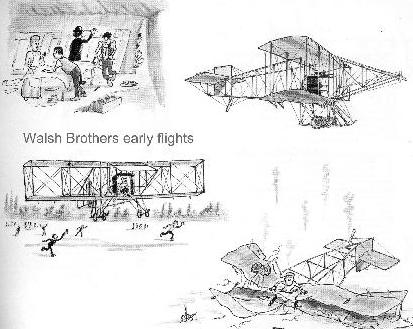|
|
|
THE WALSH BROTHERS
By Geoffrey Rodliffe
|
| |
|
The next appearance on the aviation scene, was one of the
most notable in our aviation history. In 1910, two Auckland brothers,
Leo and Vivian Walsh, backed by an enthusiastic syndicate, imported a Howard
Wright Farman biplane in kitset form. For the considerable sum of
$1530, the kitset consisted mainly of rolls of wire and cloth along with
the engine, and roughly cut spars and straits, with drawings supplied.
The brothers set to work, and by late 1910, the airframe was completed.
This was then transported to a field at Glenora Park, Papakura, and under
a large marquee, Leo and Vivian assisted by their sisters, Misses Veronica
and Doreen Walsh, commenced the painstaking task of fitting the fabric
covering.
Finally the job was completed, and the aeroplane wheeled
out for testing. On its tail was painted the inscription-The Walsh Aeroplane
Company, Aeronautical Engineers, Constructors, Auckland, Registered No.
1, with a crest below encircling the words, Aero Club New Zealand.
So was born the first aero club and its first aeroplane.
|
|
 |
The initial tests were carried out without ailerons fitted. The
aircraft bounced into the air several times as it taxied at speed around
the field. After adjustments to the undercarriage and rigging wires,
the ailerons were fitted and the biplane was ready to fly. Vivian
Walsh was the pilot, but with no instructions of any sort, he was obliged
to teach himself by trial and error. He was, however, a careful and
studious man and felt his way with skill and patience. On February 5, 1911,
the first public demonstration was made. The small group of onlookers,
including his family, had the privilege of observing the first controlled
flight to be made in New Zealand.
Newspapermen and photographers flocked to the scene as the success of
the flight became known. Sir Joseph Ward personally christened the
aeroplane "Manurewa" which appropriately, is the Maori word meaning floating
bird, In March 1911, a further public demonstration was arranged, arid
before a crowd of spectators, Vivian took the "Manurewa" to a height
of 60of 60 feet in a fine demonstration. During take-off for a second
flight the undercarriage skid caught on an unseen mound, and with a splintering
crash, the aircraft flipped over on to its back in a cloud of dust.
As the dust cleared it was seen that the aircraft was almost a total wreck,
but remarkably, Vivian crawled out without serious injury.
|
|
|
|
Despite the serious damage sustained, "Manurewa" was rebuilt, and Vivian
was to carry out more flights in her. The syndicate backing the Walsh brothers,
however, became impatient to have the aircraft demonstrated in Auckland,
but Leo and Vivian were not prepared to do this, until they were perfectly
confident of their own, and the machine's ability, This difference of opinion
led to the machine being taken from the hands of the coristructors and
pilot. Thus terminated the Walsh brothers first excursion into New
Zealand aviation. |
|
|
|
|
| Other News Stories
(For the latest news please
checkout our home page) |
| |
| |
|
|

|


